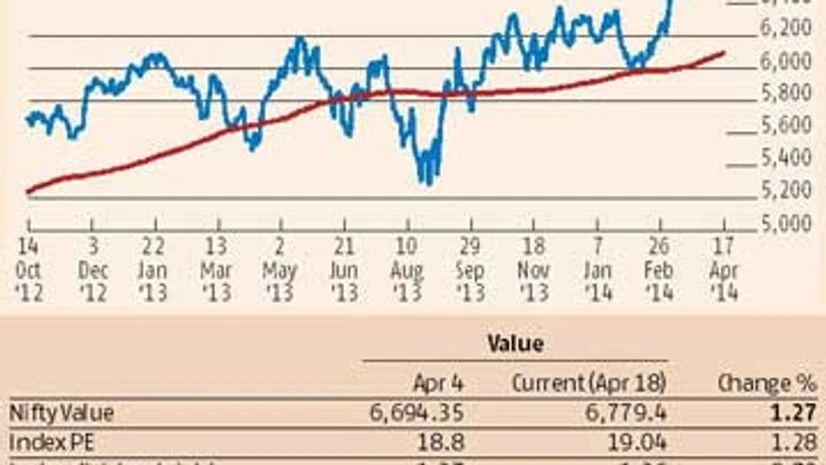This election campaign has apparently presented voters with black and white choices. They can either vote for economic revival and a multi-year bull run accompanied by high growth. Or they can let the economy continue its descent. However, rhetoric aside, there isn't much real difference between the likely economic policies of the two major parties. Both offer left-leaning economics with massive dollops of cronyism.
If you don't believe me, go to the website, India.isidewith.com. This has an extensive online survey. Respondents can check off preferences on issues such as corruption, black money, legal reform, domestic violence, caste-based reservation, foreign policy, religious discrimination, educational and health care policies and so on.
Play with the options and multiple choices. You will receive some assessment such as "Parties you side with - INC 78 per cent, BJP 81 per cent" or vice versa. It is difficult to state preferences that result in significant differences between the Congress and Bharatiya Janata Party (BJP) positions.
Neither party seems capable of substantial labour reform, cutting fuel and fertiliser subsidies, reworking the food-supply chain to reduce inflation, undertaking substantive mining or power sector reforms, reviewing reservation policies and so on. Ergo, neither party can really think out of the box to find ways to really turbocharge growth rates.
What is disconcerting for the long-term investor is the fact that the overseas investment community has bought the binary narrative wholesale. In the past three months, the foreign institutional investors (FIIs) have pumped close to $5 billion into Indian equity and another $5 billion into Indian debt. As a result, stock prices have hit a sequence of successive highs.
Market index discounts don't seem too high in isolation. The PE ratio for the Nifty and Sensex is around 19, which is quite close to the long-term average. But earnings expectations are very low at the moment. In many cases, price-earnings to growth ratios are discounting two-year forward earnings (FY 2014-15 and 2015-16) or even more.
What is more, the current valuations ignore the risk of a potentially weak monsoon due to El Nino. They also may be placing too much reliance on opinion polls, which suggest that a stable BJP-led National Democratic Alliance government is highly probable. India's first-past-the-post electoral system with its heterogeneous voter base and multiple parties is notoriously difficult to model and there could be panic if the BJP cannot stitch a government together.
At this instant, a prudent investor with India exposure should be aware that growth is weak and showing no great signs of improvement while inflation is rising again. The Index of Industrial Production dipped 1.9 per cent in February 2014, over February 2013, and FY2013-14 is expected to be the worst for manufacturing in a decade. Inflation spiked in March 2014. The wholesale price index is up to 5.7 per cent and consumer price index at 8.3 per cent.
Any investor in India should also know that there are currency risks in both directions; demand weakness if there's a weak monsoon; food inflation risks from a weak monsoon; policy risks across sectors like mining, energy and so on. A strong clear-headed government may be able to cope with all this in the long run. But these are intractable problems and they will not be sorted out inside the next six months.
On the positive side, there is very little danger now of an external balance of payment crisis. The trade deficit for 2013-14 is down to a three-year low of $139 billion. Reserves have risen to $309 billion and the current account deficit is down to $36 billion. Exports have grown by four per cent to $313 billion, while imports shrank eight per cent to $451 billion.
The close correlation between export performance and currency weakness was apparent. Between July 2013-January 2014, the rupee was weak and exports rose. In February-March 2014, the rupee rose on FII inflows while exports declined in both months. This is a "Dilli Ka Laddoo" situation.
The Reserve Bank of India (RBI) will have the pleasant task of keeping the rupee in a sweet spot without letting it get too strong, or too weak. This means buying/selling dollar and juggling money supply to sterilise forex inflows or outflows. RBI must also tackle inflation and there is a chance that it may raise policy rates if the monsoon is weak.
Corporate results have just started coming in. Reliance Industries' revenue is flat, though refining margins are up. In the information technology (IT) sector, HCL Tech and TCS have done better than Wipro, which has done better than Infosys. All IT companies will probably need to revise 2014-15 earnings projections downwards if the rupee remains strong.
There isn't enough data to make judgement calls about Q4 in other sectors yet, except for automobiles, where we know that demand was weak for the second year in succession. Society of Indian Automobile Manufacturers President Vikram Kirloskar estimated off-the-cuff that the industry has suffered over 100,000 of job losses.
The recent Supreme Court ruling that allows the CAG to audit the accounts of telecom companies (which offer revenue shares to government) has also caused serious apprehension. The principle could be extended to many other sectors.
However, none of this will make a visible difference to stock prices while the FII buying continues to run at these levels. So long as the music is playing, you have to dance, as the CEO of Citigroup once famously said about the Subprime bubble. The data suggest that retail has also turned positive on the stock market in the past 10 sessions (domestic institutions, led by LIC, remain net sellers.)
Mechanical trend-following systems are obviously screaming "buy" at the moment. Discriminatory traders will probably review their holding on the eve of election results (May 16). Until then at the least, sentiment is liable to stay positive.
Disclaimer: These are personal views of the writer. They do not necessarily reflect the opinion of www.business-standard.com or the Business Standard newspaper

)
